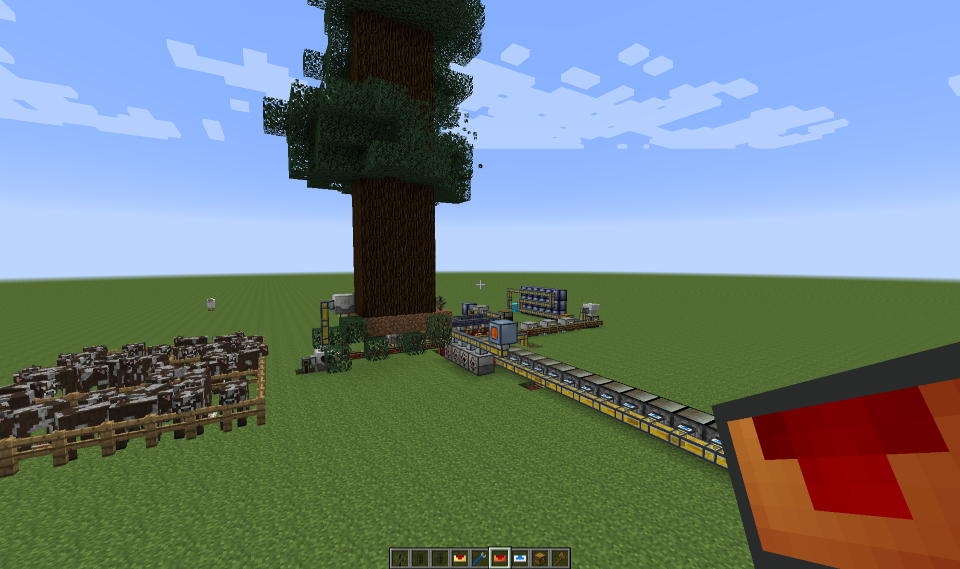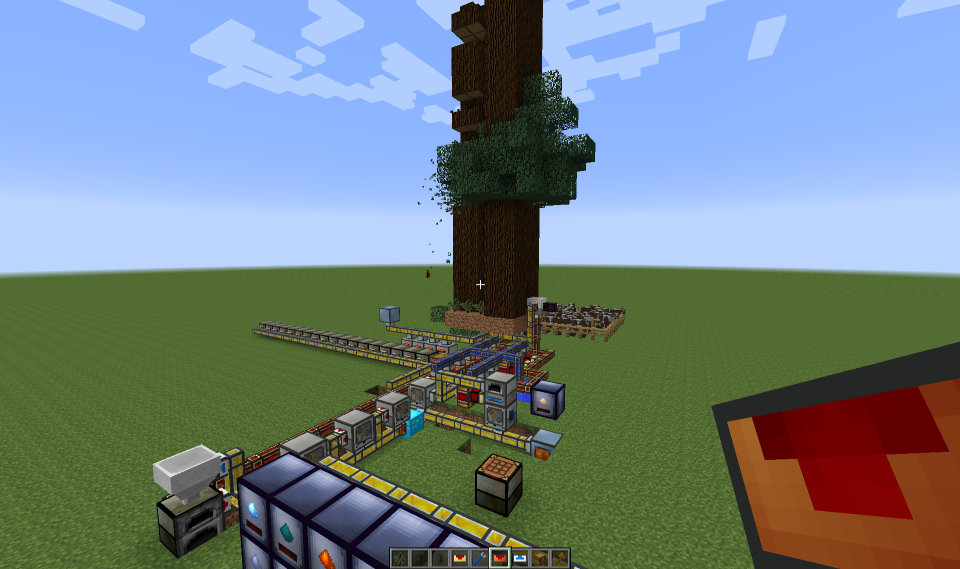Hints on Scrap Farms - OreCruncher/ThermalRecycling GitHub Wiki
To invent, you need a good imagination and a pile of junk. – Thomas Edison
First off the only scrap farm that is right is the one you are happy with. If you want to build a scrap farm that is highly efficient that maximizes scrap yield while minimizing resource investment, great! Want a scrap farm that is worthy of Rube Goldberg’s praises, even better!
It is possible to farm scrap. Key is finding the right source material and setting up the right Thermal Recycler configurations to make the scrap. Below are suggestions of what to look for and considerations when building a farm. Your mileage may vary depending on what mods are in your modpack.
The discussion below assumes that the farm is producing Wood Logs and Saplings. Mods such as MineFactory Reloaded and Forestry have mechanisms for automating such production. I am sure there are other mods that do similar things. The key is having some sort of renewable source of material to scrap.
For a Wood Log, the scrapping recipe could produce a single piece of Sawdust. The actual output is dependent on the core installed in the Thermal Recycler. Below is a table of possible outcomes for items that have a scrap value of NONE:
| Outcome | No Core | Basic | Hardened | Reinforced | Resonant | Ethereal |
|---|---|---|---|---|---|---|
| Destroy | 52.% | 37.95% | 20.0% | 10.53% | - | - |
| Debris | 47.5% | 39.28% | 20.0% | 10.53% | - | - |
| Keep | - | 11.39% | 30.0% | 57.89% | 85.0% | 100% |
| Dust | - | 10.44% | 27.5% | 17.76% | 10.83% | - |
| Inferior Scrap | 0.5% | 0.95% | 2.5% | 3.29% | 4.17% | - |
| Standard Scrap | - | - | - | - | - | - |
| Superior Scrap | - | - | - | - | - | - |
Several things to note from the chart:
- There is no chance to get Standard and Superior scrap directly from scrapping NONE items. To have a chance to get those scrap items you will need to process the Inferior Scrap in a Thermal Recycler with an Extraction core installed. Of course it is recommended to make Scrap Boxes first.
- To maximize Inferior Scrap yield install a Resonant core. There is a 8x more chance over no core installed, and just over 4x more than a Core: Decomposition (Basic).
- If you want Debris in order to supplement a power system run the Thermal Recycler without a core. The scrap operation is faster and has the highest yield of Debris.
- The Hardened core is much better than the Basic core for scrapping and should be readily accessible. If you have the resources skip the Basic core.
- For items such as logs and saplings the scrap output is Sawdust. This means that Keep and Dust outcomes will always result in Sawdust. Based on the chart above the better the core the more chance of getting Sawdust.
Depending on what you are trying to accomplish you can prep the logs prior to scrapping. Running a log through a Sawmill will produce 6 planks. Each of those planks can be scrapped individually. Furthermore, any Sawdust can be combined into Compressed Sawdust, smelted into Charcoal, and the resulting Charcoal run through the scrapping process. Of course the Charcoal could be used as fuel in a power system.
To help automate the process of making Scrap Boxes and Compressed Sawdust use Thermal Expansion’s Cyclic Assembler. If you happen to have RFTools in the pack take a look at it’s Crafter. BuildCraft’s Autocrafter is OK, but the Cyclic Assembler and RFTools Crafter are better suited for automation.
The operation of the Thermal Recycler has been tuned for farm situations where there is a large volume of repeat work that occurs. Based on this here are some thoughts on server impacts:
- Giving a Thermal Recycler the same item type over and over has the smallest impact on the server. What this means is if a Thermal Recycler is scrapping coal and you keep feeding it coal, it can reuse a lot of the cached information which minimizes the overhead of calculation.
- The Thermal Recycler is smart enough to remember the last six different item types it scrapped. So in our farm if the Thermal Recycler is scrapping carrots, potatoes, and wheat it will remember what it did for each of those and reuse any cached information. It’s not as efficient as the first case above, but again it is better than recalculating.
- Worse case is if a Thermal Recycler is getting different items and not matching what it just recently completed or doesn’t match what’s in its internal operation cache. In this case the Thermal Recycler has to calculate what it needs to do. If the Thermal Recycler is not heavily used the impact is negligible. If it is heavily used it’s not efficient. Segment the farm so that the piping system favors Recyclers based on item type.
- Buffering input to the Thermal Recycler with Hoppers or BuildCraft chutes can make things “chatty” between the Thermal Recycler and those buffering devices. On a small scale it doesn’t add too much overhead, but in large scale farms it could cause lag issues for the server.
These screenshots are of a scrap farm I built for performance profiling. It is not the most efficient way to do things, but it should give you an idea of what is possible.
The farm uses MineFactory Reloaded for harvesting vanilla Spruce trees. The cows provide sewage which is converted to fertilizer to make the Spruce trees grow faster. Sawmills cut the logs into planks, which in turn are fed into the Thermal Recyclers. Debris and Sawdust are converted to fuel for the Steam Dynamos. A series of Cyclic Assemblers combine the various scrap levels into Scrap Boxes which are fed to a dedicated Thermal Recycler with an Extraction core. The output is then sent to the cache wall.


- Pistons
- Forestry Crates